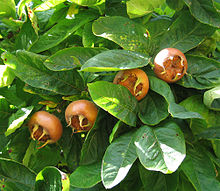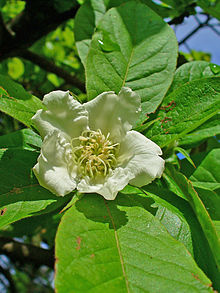- Mespilus germanica
-
This article is about a species of flowering plants called Medlar. For other uses, see Medlar.
Mespilus germanica 
Common Medlar foliage and fruit Scientific classification Kingdom: Plantae (unranked): Angiosperms (unranked): Eudicots (unranked): Rosids Order: Rosales Family: Rosaceae Genus: Mespilus Species: M. germanica Binomial name Mespilus germanica
L.Mespilus germanica, known as the common medlar is a large shrub or small tree, and the name of the fruit of this tree. Despite its Latin name, which means German or Germanic medlar, it is indigenous to southwest Asia and also southeastern Europe, mostly the Black Sea coasts of modern Turkey. It may have been cultivated for as long as 3000 years.[1]
Until recently, Mespilus germanica was the only known species of medlar. However, in 1990 a new species was discovered in North America, now named Mespilus canescens. The Loquat, Eriobotrya japonica, is also related, and sometimes called the "Japanese medlar".
Mespilus germanica requires warm summers and mild winters and prefers sunny, dry locations and slightly acidic soil. Under ideal circumstances, the deciduous plant grows up to 8 metres (26 ft) tall. Generally, it is shorter and more shrub-like than tree-like. With a lifespan of 30–50 years, M. germanica is rather short-lived. M. germanica leaves are dark green and elliptic, 8–15 centimetres (3.1–5.9 in) long and 3–4 centimetres (1.2–1.6 in) wide. The leaves turn red in autumn before falling.
The five-petaled white flowers, produced in late spring, are hermaphrodite and pollinated by bees. The reddish-brown fruit is a pome, 2–3 centimetres (0.79–1.2 in) diameter, with wide-spreading persistent sepals giving a 'hollow' appearance to the fruit.
Mespilus germanica fruit are very hard and acidic. They become edible after being softened, 'bletted', by frost, or naturally in storage given sufficient time. Once softening begins the skin rapidly takes a wrinkled texture and turns dark brown, and the inside reduces to the consistency and flavour reminiscent of apple sauce. This process can be a cause of confusion to new medlar consumers, as a softened fruit can give the appearance that it has spoiled.
Contents
Cultivation and uses
Mespilus germanica was already being cultivated about three thousand years ago in the Caspian Sea region of northern Iran. It was introduced to Greece around 700 BC and to Rome about 200 BC. It was an important fruit plant during Roman and medieval times. By the 17th and 18th century, however, it had been superseded by other fruits, and is very rarely cultivated today. M. germanica pomes are one of the few fruits that become edible in winter, and an important tree for gardeners who wish to try to have fruit available all year round. There are several cultivars, including 'Royal', 'Nottingham', and 'Dutch', which bears the largest fruit. M. germanica plants can be grafted on to the rootstock of another species, for example the pear, to improve their performance in different soils.
Once bletted, the fruit can be eaten raw, and are often consumed with cheese as a dessert, although they are also used to make medlar jelly and wine. Another dish is "medlar cheese", which is similar to lemon curd, being made with the fruit pulp, eggs, and butter.
Cultivars of Mespilus germanica that are grown for their fruit include 'Hollandia', 'Nottingham', and 'Russian',[2] 'Dutch' (also known as 'Giant' or 'Monstrous'), 'Royal', 'Breda giant', and 'Large Russian'[3]
 External images
External images
Half-bletted medlar, showing both white (ripe, unbletted) and brown (bletted) flesh[4] In literature
A fruit which is rotten before it is ripe, the medlar is used figuratively in literature as a symbol of prostitution or premature destitution. For example, in the Prologue to The Reeve's Tale, Geoffrey Chaucer's character laments his old age, comparing himself to the medlar, which he names using the slang term "open-arse":
- This white top writeth myne olde yeris;
- Myn herte is mowled also as myne heris —
- But if I fare as dooth an open-ers.
- That ilke fruyt is ever lenger the wers,
- Til it be roten in mullok or in stree.
- We olde men, I drede, so fare we:
- Til we be roten, kan we nat be rype;
In Shakespeare's Timon of Athens, Apemantus forces an apple upon Timon: "The middle of humanity thou never knewest, but the extremity of both ends. When thou wast in thy gilt and perfume, they mock'd thee for too much curiosity; in thy rags thou know'st none, but art despised for the contrary. There's a medlar for thee; eat it", perhaps including a pun on "meddler", one who meddles in affairs, as well as on rottenness. (IV.iii.300-305).
In Shakespeare's Measure for Measure, Lucio excuses his denial of past fornication because "they would else have married me to the rotten medlar." (IV.iii.171).
In Shakespeare's As You Like It, Rosalind makes a complicated pun involving grafting her interlocuter with the trees around her which bear love letters and with a medlar "I'll graff it with you, and then I shall graff it with a medlar. Then it will be the earliest fruit i' th' country; for you'll be rotten ere you be half ripe, and that's the right virtue of the medlar." (III.ii.116-119).
In Cervantes' Don Quixote the eponymous hero and Sancho Panza "Stretch themselves out in the middle of a field and stuff themselves with acorns or medlars."
In the 16th and 17th centuries, medlars were also bawdily called "open-arses" because of the shape of the fruits, inspiring the presence of boisterously or humorously indecent puns in many Elizabethan and Jacobean plays.
The most famous reference to medlars, often bowdlerized until modern editions accepted it, appears in Shakespeare's Romeo and Juliet, when Mercutio laughs at Romeo's unrequited love for his mistress Rosaline (II, 1, 34-38):
- Now will he sit under a medlar tree,
- And wish his mistress were that kind of fruit
- As maids call medlars, when they laugh alone.
- O Romeo, that she were, O that she were
- An open-arse and thou a pop'rin pear!
Thomas Dekker also draws a saucy comparison in his play The Honest Whore: "I scarce know her, for the beauty of her cheek hath, like the moon, suffered strange eclipses since I beheld it: women are like medlars._no sooner ripe but rotten"
Another reference can be found in Thomas Middleton's A Trick to Catch the Old One in the character of Widow Medler, impersonated by a courtesan, hence the following pun: "Who? Widow Medler? She lies open to much rumour." (II, 2, 59).
In modern literature, some writers have also mentioned this fruit:
Saki uses medlars in his short stories, which often play on the decay of Edwardian society. In "The Peace of Mowsle Barton", the outwardly quiet farmstead features a medlar tree and corrosive hatred. In "The Boar Pig", the titular animal, Tarquin Superbus, is the point of contact between society ladies cheating to get into the garden party of the season and a not entirely honest young schoolgirl who lures him away by strategically throwing well-bletted medlars: "Come, Tarquin, dear old boy; you know you can't resist medlars when they're rotten and squashy."
D. H. Lawrence: "Wineskins of brown morbidity, autumnal excrementa ... an exquisite odour of leave taking".
Vladimir Nabokov in Ada or Ardor briefly mentions a poet named Max Mispel, "another botanical name".
References
- ^ Baird, J.R.; Thieret, J.W. (1989). The Medlar (Mespilus germanica, Rosaceae) from antiquity to obscurity. Economic Botany. 43(3): 328–372. preview
- ^ Phipps, J.B.; O’Kennon, R.J.; Lance, R.W. 2003. Hawthorns and medlars. Royal Horticultural Society, Cambridge, U.K.
- ^ Glowinski, L. 1991. The complete book of fruit growing in Australia. Thomas C. Lothian Pty Ltd, Port Melbourne, Victoria.
- ^ The Art and Mystery of Food: Medlar fruit and Jelly
External links
Wikimedia Foundation. 2010.





